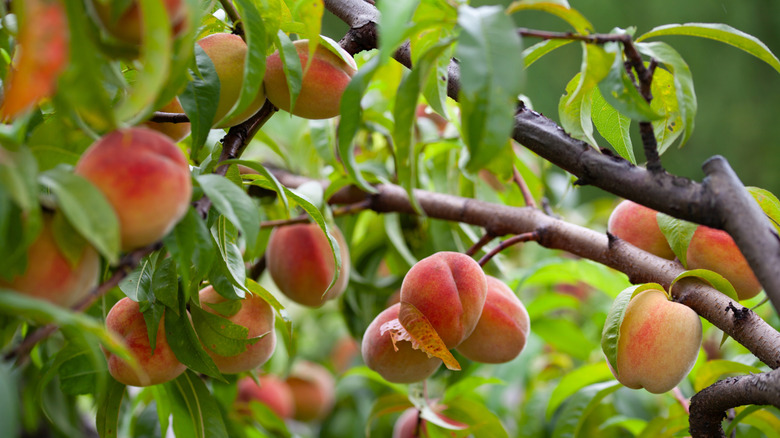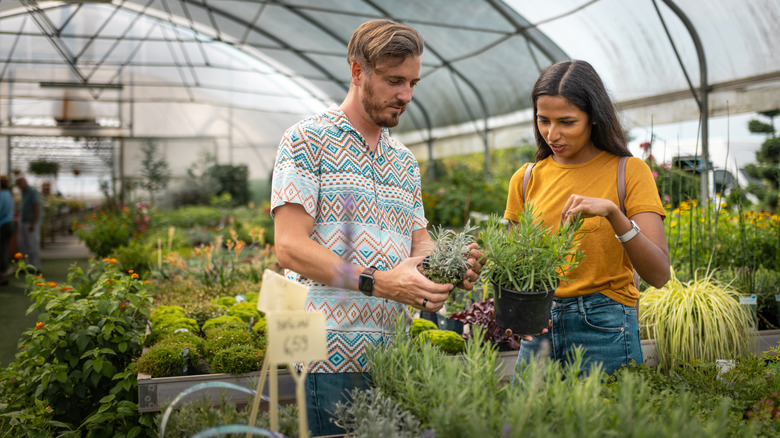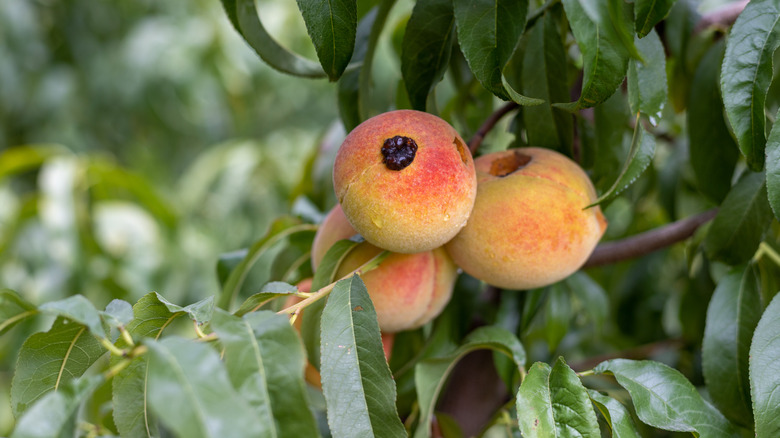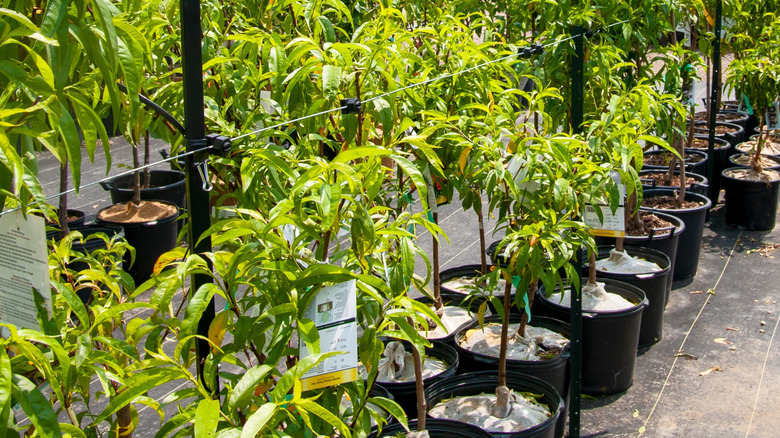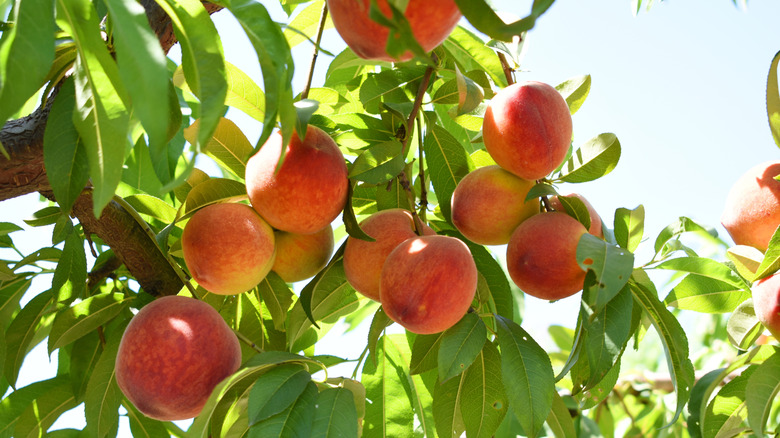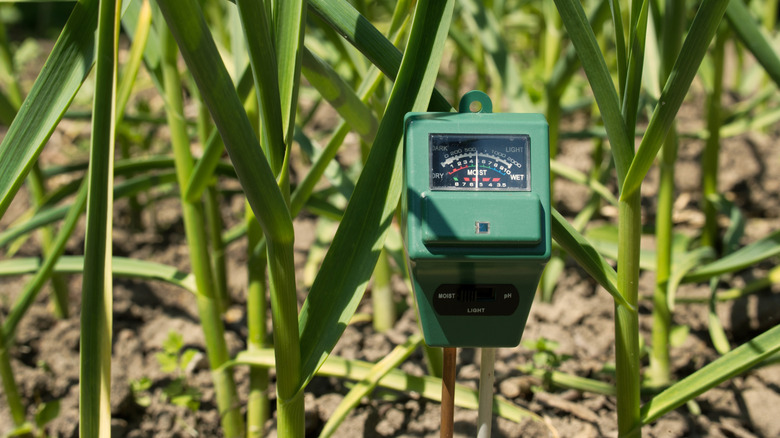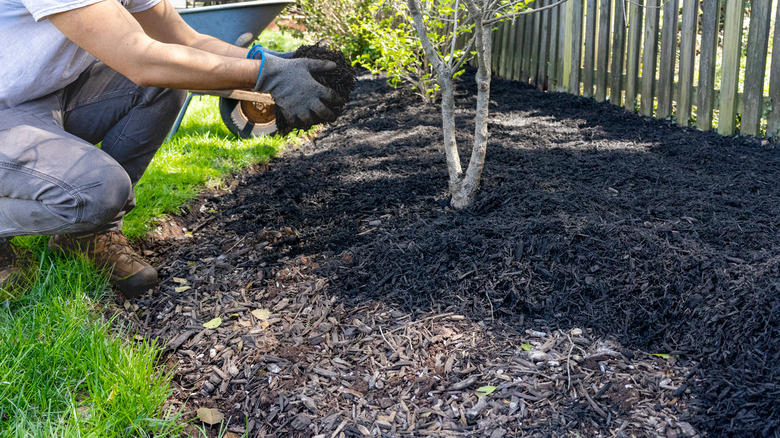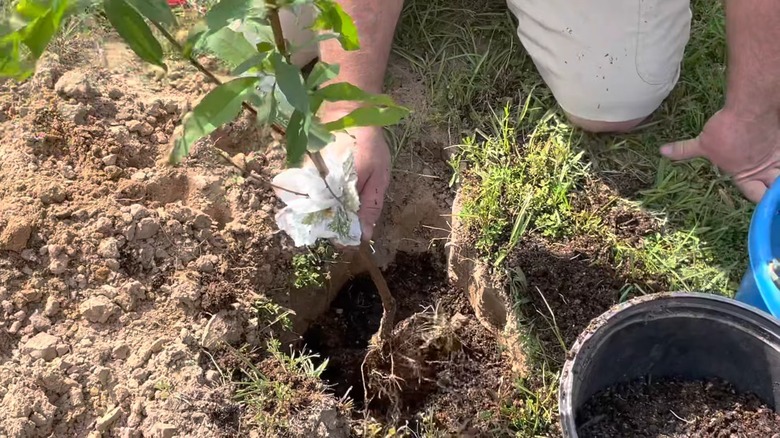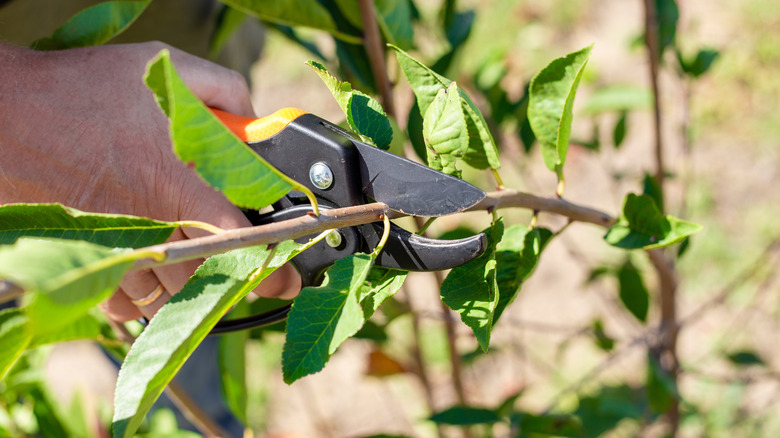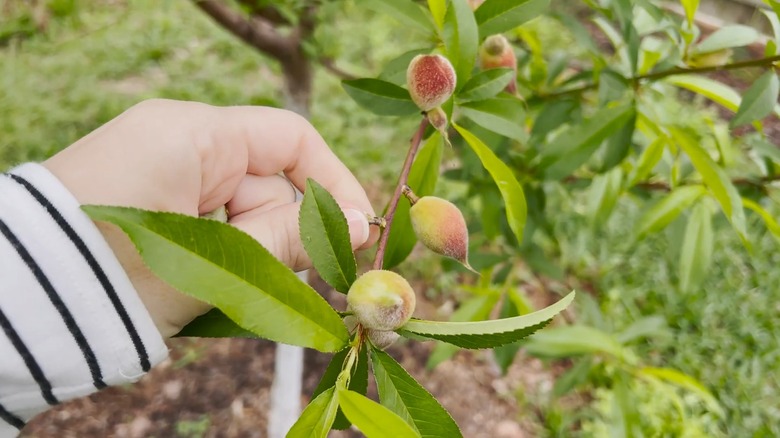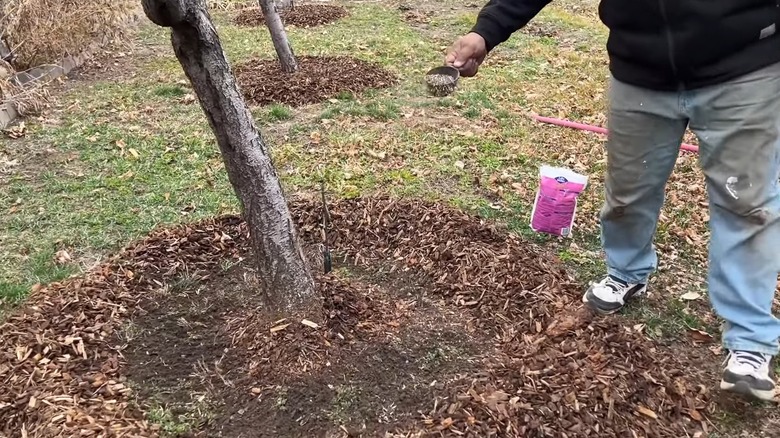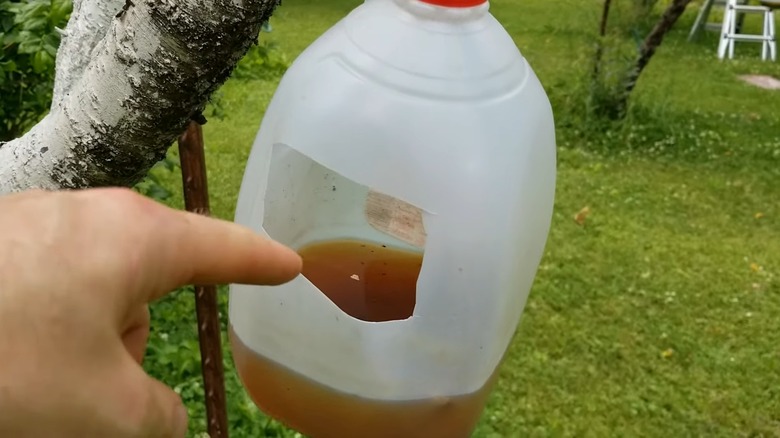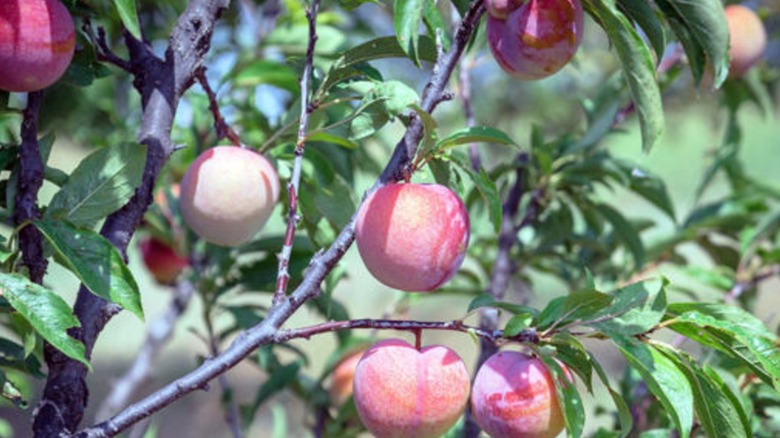Essential Gardening Tips For Growing Healthy Peach Trees
We may receive a commission on purchases made from links.
Few things rival the delightful experience of biting into sweet peaches plucked off your backyard tree. Unfortunately, they aren't the easiest to grow. Since they favor warm climates, these trees struggle to survive in cold conditions unless they're given special care. Their high susceptibility to pests and diseases also cuts their life short, with peach trees typically dying within 12 years of planting. In other words, you can't rely on them to bear fruit for your children forever.
However, don't let this dissuade you from planting peach trees. Implement a few essential gardening tips to extend their life span and improve their productivity. Start with the right selection, taking sourcing, chill hours, and disease resistance into account. Meet their favored cultural requirements of ample sun, soil pH levels, and excellent drainage. Once they're sited in the right location, focus on watering, fertilizing, pruning, mulching, and thinning them correctly. Adequate pest control management should provide lasting benefits toward healthy tree development. Now that we've outlined the basic principles, get ready to implement the gardening tips discussed below to grow the best peaches you've ever tasted in your life.
Source young trees from local nurseries
While it's convenient to purchase peach trees directly from big box stores, this may not always be conducive if you're looking to maintain healthy trees in the long run. This is because they don't always carry the trees best suited to your climate. Since peach trees can't handle extreme cold and often perform poorly in cool springs, picking cultivars or varieties that have been bred to withstand such temperatures is essential. Otherwise, they'll fail. Your local nursery will usually carry such specimens, along with specific growth information. So, make them your go-to source when planning and planting a fruit orchard.
Be sure to purchase only one-year-old specimens. Even though ones aged two or older will fruit sooner, their framework is already partially set. To minimize disease pressure, peach trees are trained into an open center shape and their desired branches are selected within the initial year. As older specimens have already invested their energy into developing branches higher up, they don't carry many buds on their lower limbs, which makes their training difficult and jeopardizes their long-term health. Plus, the young ones are cheaper, helping you save money. That being said, check the trees for diseases, especially galls, as they can't be treated later. Stick to 3 to 4-foot-tall peach trees with healthy roots.
Choose a disease-resistant variety
The key reason why growing fruit trees, especially peaches, isn't the most beginner-friendly endeavor is that they're susceptible to a legion of diseases, which cuts their life short. And if you don't follow a chemical spray regime, it can be challenging to maintain a healthy fruit orchard. That's why you should invest in disease-resistant varieties. Although disease-resistant trees aren't completely immune to the earmarked disease, they can better handle the pressure, which significantly lowers the need for chemical treatments.
Peach trees often fall prey to bacterial spot disease, which riddles the leaves with holes and, in advanced stages, causes complete defoliation of the tree. It also affects fruit quality and can't usually be successfully treated in home gardens. To avoid this infestation as best you can, consider growing options, such as 'Ambergem,' 'Bellaire', 'Cardinal', 'Candor', 'Cherryred', 'Desiree', 'Dixired', 'Glohaven', 'Norman', and 'Southhaven'. But if you prefer white peaches, look for 'Southern Pearl' or 'White River'. However, if you reside in areas where root-knot nematodes are a nuisance, look for peach trees grafted on 'Nemaguard' or 'Guardian' rootstock, as they offer in-built resistance.
Pay attention to the tree's chill hour requirements
Although hardiness levels help identify the range where peach trees can thrive without undue stress, they aren't enough to ensure future health and production. You also need to consider their chill hour requirements. Essentially, in winter, peach trees need a few set hours where nighttime temperatures oscillate between 32 and 45 degrees Fahrenheit to wake their dormant buds. These hours must add up by January 1st, so the tree can sprout flowers in spring and produce fruit shortly after. If their requirements go unmet, peach trees won't be able to green up in time or flower. Ultimately, this will derail fruit production. And if they do grow, the fruit may appear distorted and crooked. Conversely, if you grow a peach tree with fewer chill hour requirements in cold climates, the buds may become damaged during spring frosts, causing you to forgo that year's fruit production.
Check with your local state extension or nursery for peach trees whose chill hour requirements can be easily met in your zone. For instance, it'll be difficult to fulfill high chill hour requirements in coastal areas or Florida. So, stick to varieties with lower demands, possibly in the range of 300-ish hours, such as 'FloridaCrest' or 'UFGold.' Those up north should look for varieties with greater chill requirements that can be met on average in your area.
Site peach trees where they receive at least morning sun
Another gardening tip essential to successfully grow a peach tree is to meet its light requirements, especially when it's most required. While it's fairly known that fruit trees produce and maximize their fruit production when they're exposed to the sun throughout, or at least for the better part of, a day, morning exposure is key to enhancing long-term health. That's because the early day rays dry out the dew collecting on their foliage, which could otherwise help disease-causing organisms, especially fungal spores, to enter the tree. So by eliminating the dew, you reduce the chances of diseases. This same phenomenon allows pathogens to capitalize on the fruiting stage's wet conditions and spread uninhibited.
So, to reduce the disease pressure and ensure adequate tree health, site peach trees where they receive at least eight hours of direct sunlight. If it happens to be an elevated site, ensure the area is shielded away from desiccating winds or allows the cold winds to drift downward. This will keep the flowering buds and fruits from getting damaged.
Amend the soil to adjust pH levels
While peach trees are adaptable to a variety of soil conditions, they're finicky about pH levels. Most varieties prefer the soils to be slightly acidic to neutral, with the pH settling at about 6.5 to ensure maximum nutrient absorption. Swing away from this level in either direction, and you'll be left with a very unhappy tree.
If you're dealing with a highly acidic soil, consider sprinkling lime in your garden to watch your plants thrive. Jobe's Organics Garden Lime is one option. Apply it based on a soil test, though you can generally work lime about 1 foot deep into the soil in a 10-foot radius of the tree. In contrast, when dealing with alkaline soils, consider incorporating chelated iron, like Fertilome's Chelated Liquid Iron, into the soil. This is because its absorption is hindered the most in alkaline sites, and iron deficiency can lead to interveinal chlorosis, a condition under which the tree foliage grows discolored or faded and is ultimately shed, killing the tree.
Mulch the tree root zone
To help peach trees flourish in your garden, mulch their roots. This is important for multiple reasons. When you keep the beds mulched, they tend to retain water for longer, guaranteeing the trees' ability to access resources as required. Plus, mulch keeps weeds down, or they'd battle the trees for crucial resources, impeding their growth. Winter weeds, in particular, serve as hotbeds for overwintering pests and fungal spores that may later attack the tree during the spring season. With mulch effectively blocking the weeds from germinating or producing shoots, young peach trees can grow healthily. It also plays an effective role in shielding the trees from cold damage. Moreover, it insulates and warms the roots, ensuring unimpeded growth and top-notch tree health.
To enjoy these benefits, apply nearly 3 to 4 inches thick of mulch over a 3-foot area around your peach tree. However, carefully choose the best type of mulch for your garden. Ideally, you'd want organic materials, such as bark mulch or wood chips. This is because inorganic mulches, like landscape fabrics or warm straw layers, can cause the water to pool and the plant to rot. Another downside is that they can be used by voles as an overwintering habitat. Since they don't shy away from gorging on the tender bark, your peach trees may take irreversible damage. In the worst circumstances, they may even lose their lives.
Plant peach trees in raised beds for better drainage
Peach trees draw the line at poor drainage. They can't withstand wet feet and expect water to filter down swiftly. When permeation isn't fast enough, the roots develop rot and get decimated. This limits plant growth and proves fatal shortly. So, to ensure your peach trees don't lose their vigor, ensure they're located in well-draining soils. If you're dealing with heavy, clay soils, layer in soil conditioners like compost to improve drainage. Otherwise, plant your peach tree in raised beds.
Make sure the raised beds stretch at least 3 feet across and plant the peach trees at a shallow depth. Since you want to minimize air pockets that may risk the root system to diseases, match the tree's planting depth to the levels it sat at in the nursery. That way, you can help your fruit tree grow and produce faster, as peach ones maximize their foliage and trunk growth in similar conditions. Just note the color difference between the root system and the bark for the right planting depth. If that proves unfruitful, just ensure that the highest root sits no lower than 2 inches in the soil.
Water strategically for root development
For them to thrive in their location, it's important to water your peach trees properly. Since they develop shallow roots, they're less resistant to drought stress. So, when you under-irrigate them, they experience water stress. This can be especially damaging during the fruit development or "final swell" stage, when water needs increase significantly. Conversely, when you overwater the trees, the waterlogged soil becomes a hotbed for rot-causing organisms. Alternatively, the roots experience stunted growth due to the leaching of essential nutrients. Sometimes, overwatering can encourage excessive foliage growth, instead of fruit production.
So, plan your watering schedule strategically to maximize root production. In the first five years, when peach trees are finding their footing, water deeply down to 18 to 24 inches. You may even mound up soil about 3 feet away from the tree trunk to prevent water runoff. This should boost soil contact for the roots, enabling steady growth. Later on, once the peach trees are fully established, water them weekly or fortnightly, depending on the amount of rainfall received. Simply check if the soil is moist down to 2 feet before watering. You don't want to water them more than 30 inches in the growing season. In case your fruit trees are in the lawn, try to spread out the irrigation sessions on sprinklers, so the peaches receive deep watering and it doesn't just pool on top.
Prune aggressively as the trees grow older
Pruning yields long-term benefits in improving your tree's health. While you can allow your peach tree to take its natural form, owing to its vigorous growth, it can grow too tall and make harvesting difficult. Besides, it may grow incapable of supporting its fruit load, since its fruiting branches were never clipped off. Consequently, the branches split under the fruits' weight, especially in frost-free areas where most flower buds survive. In turn, these wounds become entry points for pathogens, endangering tree health.
To complicate matters further, peach trees bear their best fruit on young, 18-inch-long shoots produced in the previous year. But since they grow and spread vigorously, prune them aggressively to retain fruiting capacity. Through continuous pruning of old stems, you'll encourage the trees to produce new shoots, which eventually develop fruit buds. Additionally, this will open the inner canopy, allowing greater sunlight access to the young shoots (in line with the recommended "open center" system). Pruning also helps lengthen the life of fruiting wood if it survives winter.
Since pruning can reduce a peach tree's resilience to cold, it must be carried out in early spring after the last frost, or once new growth starts, but before blooming occurs. Since the trees are growing actively, they can seal their wounds, lowering the risk of contracting diseases. To avoid making mistakes, utilize these juicy tips and tricks to successfully prune a peach tree.
Thin fruit aggressively four weeks after flowering
Although pruning will take some major crop load off your peach tree, you must further thin the fruits if you want it to remain productive for a long while. Otherwise, it'll expend most of its energy producing fruit that season, and can't set new buds for next year's harvest. Not removing excess fruit also affects the size of your harvest, saddling you with tiny peaches that don't even taste good (what an utter disappointment). Besides, as touched upon before, heavy crop loads cause limb breakage, which adversely affects tree health.
So, once your peach trees are fully enveloped in gorgeous blossoms, mark your calendars. Four weeks after this event, thin the fruiting branches. Simply hold the target stem firmly and pluck off any surplus fruit that's at least golf-sized. Since no peach should be spaced closer than 6 inches on any branch, you'll mostly have between one and three fruits on each branch.
Fertilize appropriately for tree age and growth rates
Fruit trees perform their best when their nutritional requirements are duly met. While you may have addressed nutrient deficiencies before planting peach trees, the soil profile changes as these plants mature. Initially, young trees will require more nitrogen to put out vegetative growth. Once they reach fruit-bearing age, they'll utilize these nutrients in peach production. So, taking their age and function is essential for healthy trees and quality fruit — conducting a soil test every four years should help you plan better. Besides, peach trees can be especially nitrogen-hungry. Since they don't transport many nutrients from their foliage to the trunk before winter, they need to feed more during the growing season to replace the nutrients lost during shedding. They also lose out on nutrients when their fruits are harvested, further ratcheting up the need for fertilizer.
A general rule of thumb is to track the development of new shoots on peach trees. When they're aged three or under, their new shoots should grow between 18 and 24 inches a year. But once they turn four, expect their annual growth to slow down to about 12 inches. If the growth is lacking, apply a nitrogen-rich fertilizer (20-0-0) in early spring, followed by another application in the summer, if growth is still poor. Don't fertilize juvenile trees post August 1, as it may reduce their cold resilience.
Screen the trees for gummosis and carefully design an integrated pest and disease management schedule
Throughout their lifetime, peach trees remain vulnerable to attack from various pests, such as oriental fruit moth, borer insects, scales, catfacing insects, and Japanese beetles, that damage their flowers, fruits, and foliage. Small mammals, including voles, rabbits, and mice, chew on their trunks in the winter. Worse, pathogens introduce cankers, rot, galls, scabs, and verticillium wilt into their bodies. So, keep your peach trees pest and disease-free to maintain their vigor and growth. Carefully design and follow an integrated pest management schedule, because the one-treatment-eliminates-all approach doesn't work here.
Apart from scanning your trees for physical pests, monitor the bark, buds, or fruits for any sticky sap — typically milky or red in color — when the trees leaf out in spring. Such sap, which is common under the condition of gummosis, usually indicates the presence of harmful bugs or fungal pathogens. Usually, chemical treatments can help, but if pests have already infiltrated the fruit, insecticides won't work on them. Instead deploy pheromone-based traps to pinpoint their exact location and treat them as they emerge. Also, get horticultural oil to deal with hard-bodied insects, like scales, and wrap the trees in poultry wire pre-harvesting to keep mammals out. Better still, get your hands on Clemson Fruit Bags. They're available from February to June, and are ideal for bagging up your crop and shielding it from pests and diseases, until it's ready to pluck.
Protect from late spring frosts
Since peach trees bloom early in the spring season, they're highly susceptible to frost damage. Case in point, warm spells can encourage the buds to unseal themselves. But once the temperatures drop to 20 degrees Fahrenheit (late hard frost), you'll lose the flower buds, and with them, the year's harvest. Buds that are already slightly open can tolerate even less, dying when the mercury hits 26 degrees Fahrenheit. If your peach trees have already borne fruit, expect to lose the harvest when it's around 28 degrees Fahrenheit. Late frost might not even spare the foliage. The impeded photosynthesis subsequently prevents new growth.
To avoid this damage and ensure healthy development, plant varieties that bloom late into the season and have cold-hardy flower buds (not just the tree) to guarantee their survival. 'Intrepid,' 'Encore,' 'China Pearl,' 'Contender,' and 'Redhaven' are the best options. For existing varieties, consider draping them in fleece if they've been pruned short. Or, place an overhead sprinkler near the tree. Target its water at the canopy and leave it running throughout the night. This will cause the water to continuously release heat and maintain ambient temperatures of 32 degrees Fahrenheit as it interacts with the ice layer encasing the canopy. However, this will not work in windy locations, as the air dries faster. It's also unsuitable for prolonged durations where ice buildup may eventually make the limbs heavy, breaking them.
